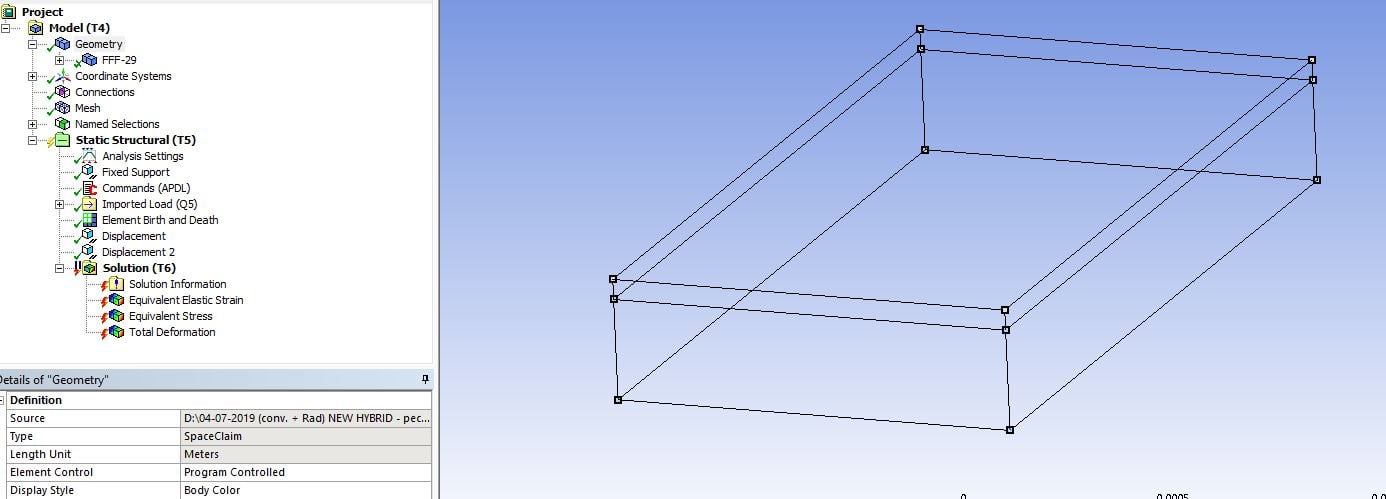-
-
October 26, 2020 at 12:21 pm
anandnitesh9a
SubscriberI am simulating a static structural simulation in which i have imported the temperature data from fluent model. But during simulation i am constantly getting an error "The solver engine was unable to converge on a solution of a nonlinear problem". I have two material in this simulation. First is structural steel (constant properties) and another one is IN718 whose properties are temp. dependent. Can anyone explain me the issues and suggest any solution for this
October 26, 2020 at 1:24 pmjonsoln
SubscriberYou should check what errors you have in the solver output. This will help you identify where the problem is.nOctober 27, 2020 at 1:33 amanandnitesh9a
SubscriberI am constantly getting this error message The solver engine was unable to converge on a solution of a nonlinear problem. Do you mean this ?nOctober 27, 2020 at 7:16 amjonsoln
SubscriberNo, click the Solution Information tab and choose Solver Output from the drop down menu. This gives you a text file with information about the solver process. Near the bottom it will list the errors that caused the solution to fail. Check what these errors are.nOctober 28, 2020 at 1:49 amanandnitesh9a
Subscriber Apart from this message I also saw this message n*** WARNING *** CP = 494.562 TIME= 09:35:59n Equivalent plastic strain increment has exceeded the specified limit n value. Since the time increment has reached the minimum value, the n iteration is continued with minimum time step used. n*** NOTE *** CP = 384.812 TIME= 09:34:08n The incremental plastic strain computed in this iteration is larger n than the criterion of 15% leading to bisection. You may try n incrementing the load more slowly by increasing the number of substeps n or use the CUTCONTROL command to re-specify this criterion. nCan you suggest me what is to be done as the next step in order to debug this error.n
October 28, 2020 at 12:13 pm
Apart from this message I also saw this message n*** WARNING *** CP = 494.562 TIME= 09:35:59n Equivalent plastic strain increment has exceeded the specified limit n value. Since the time increment has reached the minimum value, the n iteration is continued with minimum time step used. n*** NOTE *** CP = 384.812 TIME= 09:34:08n The incremental plastic strain computed in this iteration is larger n than the criterion of 15% leading to bisection. You may try n incrementing the load more slowly by increasing the number of substeps n or use the CUTCONTROL command to re-specify this criterion. nCan you suggest me what is to be done as the next step in order to debug this error.n
October 28, 2020 at 12:13 pmjonsoln
SubscriberYou have a bisection occuring due to the plastic strain increasing very rapidly somewhere in your part, and the solver continues with the minimum step size you have set. Later, the solver fails to converge at a substep in the default 26 iterations, and since you are already at your minimum step size it aborts. You could either increase the number of iterations using the NEQIT command, or increase the maximum number of substeps.nBut before you do that you should check that the displacements and loads you have applied are correct (check units) and that the material parameters are reasonable. To find out where the solver is struggling with convergence you can change Newton-Raphson residuals (under solution information) from 0 to 3 and solve the model again. This gives you a new output which shows where the forces are unbalanced. You should also take a look at the force convergence plot (also under solution information) to see how the solver is doing (was it almost converging after 26 iterations, or is it diverging?)nViewing 5 reply threads- The topic ‘Simulation not converging’ is closed to new replies.
Innovation SpaceTrending discussions- LPBF Simulation of dissimilar materials in ANSYS mechanical (Thermal Transient)
- Real Life Example of a non-symmetric eigenvalue problem
- How can the results of Pressures and Motions for all elements be obtained?
- BackGround Color
- Contact stiffness too big
- Element Birth and Death
- Python-Script to Export all Children of a Solution Tree
- Which equations and in what form are valid for defining excitations?
Top Contributors-
4592
-
1494
-
1386
-
1209
-
1021
Top Rated Tags© 2025 Copyright ANSYS, Inc. All rights reserved.
Ansys does not support the usage of unauthorized Ansys software. Please visit www.ansys.com to obtain an official distribution.
-
The Ansys Learning Forum is a public forum. You are prohibited from providing (i) information that is confidential to You, your employer, or any third party, (ii) Personal Data or individually identifiable health information, (iii) any information that is U.S. Government Classified, Controlled Unclassified Information, International Traffic in Arms Regulators (ITAR) or Export Administration Regulators (EAR) controlled or otherwise have been determined by the United States Government or by a foreign government to require protection against unauthorized disclosure for reasons of national security, or (iv) topics or information restricted by the People's Republic of China data protection and privacy laws.












